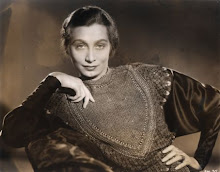None the less a delightful quiz. I am anxious to read the responses made by others but have held off doing so until we finish this. Please excuse any breaches of quiz etiquette -- attribute to my recent entry into such ranks -- and advise of same. Thank you.
Postscript: I am also a member of Advair Anonymous.

1. Which actors do you always (or did you always) mix-up?
Bonita Granville and Priscilla Lane
Bonita Granville (on the right)


Priscilla Lane (on the left)
Or is it the other way around?
2. Gidget or Beach Party?
My wife says Gidget
3. Favorite Movie Outfit?
The monks in The Private Life of Sherlock Holmes. My wife (Enola) also likes the Elizabeth Taylor outfit at the pool table in A Place in the Sun.
4. If you could be ANY character in ANY movie...who would you choose?
Rupert of Hentzau. Fairbanks Jr.
5. If you could marry ANY character in ANY movie...who would you choose?
Gerald: If I were single it would be Susan Ricci in The Spanish Prisoner or Ann Black in State and Main. Or any character played by Rebecca Pidgeon in any movie. (Mr. Mamet might object.)

6. If you could live in ANY movie...which would you choose?
Enola: Shadow of a Doubt. But only once Uncle Charlie was removed.
7. Black & White movies you wish were in Technicolor, or vice-versa?
The Long Good Friday.
8. Favorite Movie Soundtrack?
Odds Against Tomorrow. Modern Jazz Quartet (Gerald)
The Private Life of Sherlock Holmes (Enola)
And all the Allan Gray scores for the Powell/Pressberger films.
9. Favorite Movie Dance Sequence?
Gerald: Our Love is Here to Stay in American in Paris.
Enola: Begin the Beguinne (Astaire and Powell). She is probably right.
10. Coolest Movie Star? (Cough, cough, BOBBY DARIN, cough, cough -Millie)
Enola: James Coburn
11. Sophia or Gina (Oh, how Kate enjoys replaying Gina's sad defeat OVER AND OVER! -Millie)
Sophia
12. "Isn't It Romantic" in most Billy Wilder films, or "Red River Valley"
Gerald say Wilder; Enola says Ford.
13. If you could re-cast ANY role in ANY movie, what would it be?
Colin Blakely in The Private Life of Sherlock Holmes. He ruined what might have been a Wilder masterwork. Andre Morrell might have done fine, thank you.
14. Favorite movie character with your first name?
Enola has long lived with remarks about her name and a certain aircraft -- so she passes. Gable had Gerald's first and last name in No Man of Her Own.
15. One movie that should NEVER be remade? (under THE THREAT OF A SLOW, PAINFUL DEATH!)
Enola says A Canterbury Tale but Gerald suspects, although he loves it, there is little fear of that.
16. Actor or Actress who you would love to be best friends with?
Gerald would like Enola to be best friends with Rebecca Pidgeon.

17. Are you an Oscar or a Felix?
Role reversal. Enough said.
18. Actor/Actress you originally hated and now love?
Gerald never hated Harlow, but did not think much of her. He was very wrong. TCM was the antidote.
Enola was that way about Clark Gable.
19. Actor/Actress you originally loved and now don't like?
This is heresy to some, but I really liked Jack Lemmon in the early years, however, the grimacing got old. Nicholson's grimacing was always old.
20. Favorite performance that was looked over by Oscar? (Not to be confused with the aforementioned Oscar of Felix fame.)
Jean Hagen in Asphalt Jungle

21. Bewitched or I Dream of Jeannie?
Is this a repeat of Question 1?
22. Hannibal Heyes or Kid Curry? (Hint for those who don't know who they are: pick Hannibal Heyes.)
I had the latter in an Indian restaurant in Southall.
23. Favorite Style Icon: Fred Astaire or Cary Grant?
Enola thinks Grant. Gerald thinks Astaire because he had less of the initial package with which to work.
24. Single most favorite movie scene EVER?
Wendy Hiller going up the path to the castle with the three pipers.
25. Movie you really "should" see, but have subconsciously been avoiding for who knows what reason?
Should see Star Wars because of its historical place in film history but cannot rise above the damage it did by establishing the template for that which was to come.
26. Movie quote you find yourself most often repeating in real life?
The Scots phrase uttered / shouted by Pamela Brown on seeing Torquil in I Know Where I'm Going! Might some linguist help?
27. 50's Westerns or 60's Spies? (I can't even answer this myself...but you have to! MWAHAHAHA! - Millie)
Cooper, Stewart and the lot.
28. Favorite splashy, colorful, obnoxious 50's musical?
29. Favorite film setting (example: Rome, Paris, Seattle, Siberia, Chile, Sahara Desert, etc)
Gerald says Paris because he reveres Jean Pierre Melville. But Gerald was born in the South Bronx, so ...
30. If you could own the entire wardrobe of any film, which would it be?
Le Samourai. Alain Delon. Including the bird.
31. Carol Burnette or Lucille Ball?
We split. Gerald Carol. Enola Ball.
32. Favorite Voice. Ever. Period?
Ronald Colman and Joan Greenwood.
33. Favorite movie that takes place in your home-state?
Gerald: Woody Allen's Manhattan and Radio Days
Enola: Miracle of the Bells (They have since torn down the church.)
34. Which actors would you want for relatives? (Mother, Father, Grandma, Crazy Aunt, annoying cousin, older brother, etc...)
Mostly done by Enola
Grandmother: Ethel Barrymore (Gerald remembers her non-Grandmotherly days)
Annoying Cousin: Rosalind Russell
Father: Ben Johnson
Mother: Irene Dunne (Gerald opts for Spring Byington)
Crazy Aunt: Elsa Lanchester, Carmen Miranda and Edna May Oliver
Crazy Uncle: Burt Lancaster and Danny Kaye
Pet: Adolf from We're No Angels (he would be handy to have around)

Click here to access the originators of the quiz


.jpg)


















